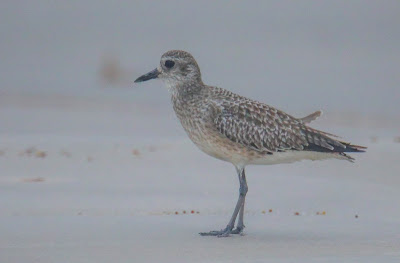The black-bellied plover breeds in the far north, mostly the Arctic, of Alaska, Canada and Russia, and portions of western Alaska below the Arctic. It then is highly migratory and winters nearly worldwide along sea coasts. In the Old World it is known as the gray (or grey) plover.
 |
| Orange is breeding, blue is winter and yellow is migratory. |
In spring and summer (late April or May to August) they have a black breast and belly, black face and neck with a white border, a white rump, and are spotted black and white on the back and wings. The bill and legs are black. From mid-August to early September they moult to their winter plumage which they keep until April. The winter plumage is a variable amount of brownish/gray mottling on the back, a smudgy face and breast and a white belly. Juveniles and first winter birds are similar to adult winter plumage, but with back feathers blacker with creamy white edging. In all plumages a distinguishing characteristic is black feathers at the base of the underwing (only visible when the bird is in flight) and black inner flanks.
I have wanted to see this bird, anticipating the breeding plumage. I finally saw some on Thanksgiving day at Padre Island National Seashore in southern Texas, but in their winter plumage.




It is such a delicate-looking bird. It's hard to believe it can handle Arctic weather, even in the warmest seasons.
ReplyDelete